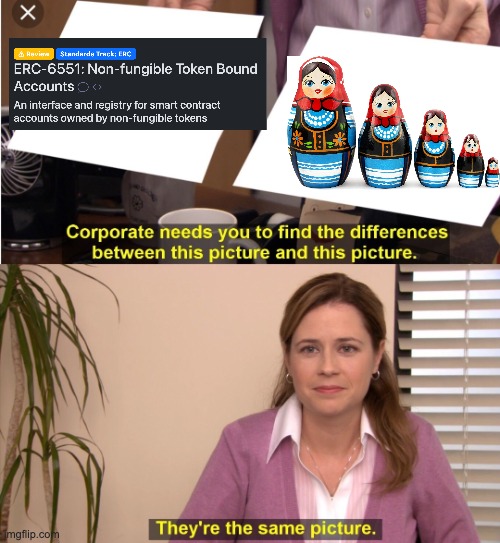Token Bound Accounts
Most people have heard of crypto. Many people also understand that Ethereum wallets can own NFTs.
But less people are aware that NFTs can also own Ethereum wallets.
This is a recent change, thanks to a new standard called "Non-fungible Token Bound Accounts". This is a big deal for Ethereum developers and users.
How it works
Most mental models of NFTs are wrong.
NFTs don't live "inside" wallets. Instead, they are stored as records in a smart contract, which keeps track of an "owner" wallet address for each token. This is confusing for users, so wallet software has evolved to show tokens inside of wallets.

Token bound accounts extend this concept. Tokens still have owners, but they can also control wallets. A wallet can own a token that controls a wallet.

This creates an abstraction like a Russian Doll. You can keep going forever. A wallet can own a token that controls a wallet that owns a token...

Why it matters
Token bound accounts work with any NFT, even if they were minted prior to the introduction of the standard.
There are some use cases I'm particularly excited about:
No more snapshots
Snapshots are point in time representations of a token's owner. They are also a massive pain in the ass to manage.
Token bound accounts means no more snapshots. Since every NFT is now permanently associated with a wallet address, you can just keep track of the wallet for each token. This makes airdrops, allowlists, and community management much easier for developers.
Upgradable NFTs
Many NFTs are deployed on permanent contracts that cannot be modified. This is good for sovereignty, but bad for ongoing feature development. Developers can now airdrop soulbound NFTs into a token bound account, which can effectively upgrade the original NFT. Since the airdropped token can't be transferred, it is then tied to whoever owns the token at the point in time.
This has applications for governance, access, and ongoing rewards for existing NFT collections. For example, existing PFP collections can airdrop a governance token to the wallet of each NFT, providing new functionality to control a shared treasury.
Cross chain wallets
Since the address of the token bound account is deterministic, a single NFT on one chain can be used to control wallets on multiple chains. This is especially useful in ecosystems like the OP Stack where multiple L2s are competing for users, and allows developers to derisk technology choices and data portability.
Conclusion
Ethereum is still a young protocol. Changes are happening frequently, and business opportunities, organizational structures, and economic models often become possible when new standards are invented. It's important to stay on the bleeding edge of these developments, especially since first mover advantages are critical in highly networked ecosystems.